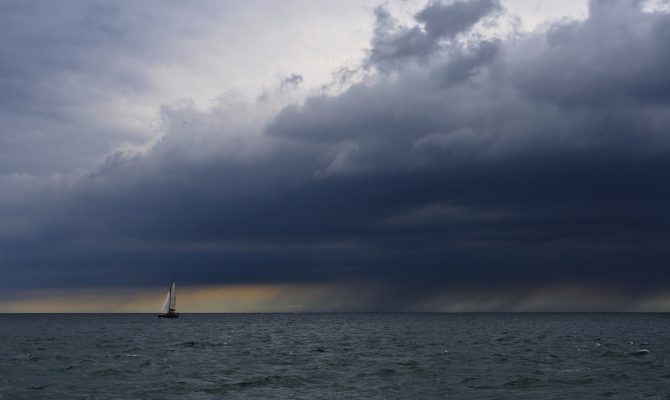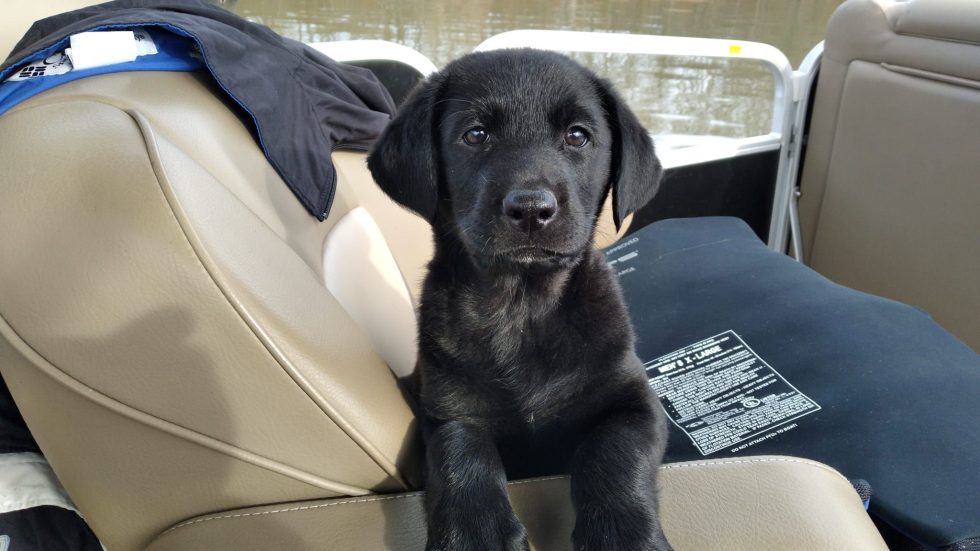We were hoping to beat out the next day’s predicted cold front, which are often preceded by thunderstorms, but it wasn’t to be. Shortly after last light the western sky lit up with an air-to-water display of lightning and the rumble of thunder. We were caught in no man’s land, too far into the Gulf to turn back and with no reachable port ahead.
If you found yourself in the same situation, what would you do?
Button Up
Loose gear — washed overboard lines, overlong dinghy painters and the consequently fouled props — constitute the majority of post-storm distress calls. Stow whatever you can, and check and tighten all lines and knots.
It’s also a good idea to deflate and, if possible, stow deck-mounted inflatables below.
Wildly flailing canvas can be dangerous. Make sure to secure your top or store it out of the way. The flaps of fully enclosed bridges should be rolled up so the wind can blow through.
Got dual stations? Opt for the lower; weight aloft will decrease the boat’s stability.
I switch all automatic pumps (bilge, galley, etc.) to manual mode, thus avoiding needless cycling due to the boat’s motion.
Getting Zapped
Your radar will help you determine the storm’s size, direction and mass. On the three-mile-or-less ring — my preference — storm cells remind me of an approaching swarm of angry bees. If there’s sea room, you can avoid or even maneuver between these cells.
Some skippers shut down their electronics upon a storm’s approach. Sure, we’ve all heard of system-scorching lightning strikes. But I believe that aids to navigation are essential, and when the visibility approaches nil, that’s when they’re needed most.
In the years I’ve been doing this stuff, I’ve never been aboard a boat hit by lightning. A properly grounded boat has about as much chance of being struck as the adjacent waters. And if lightning does strike, it will probably fry your electronics whether you’re using them or not.
Keep your radio on. Both NOAA and the Coast Guard will broadcast an alarm preceded by a tone. I also carry a handheld VHF and GPS, so if my onboard system does go down, I’ll hopefully still have navigation and communication.
Reading the Weather
Thunderstorms breed on late afternoons of hot, muggy days. Beware of haziness to the west; inland and near the coast, I’ve never seen a storm approach from anywhere other than a westerly direction.
The variations in temperature between the hot surface air and the cool upper atmosphere contribute to the classic anvil-shaped thunderheads that can erupt so spectacularly. But sometimes you’ll never see that anvil; the sky will get duller and darker, and suddenly the thing is on you.
A thunderstorm is generally preceded by an abrupt drop in temperature and, often, a dramatic change in wind direction. This is not the time to outrun the beast. If it looks like you’re about to get creamed and can’t make it to a safe haven in time, anchor if you are able to do so. Allow as much scope as possible and power into the wind enough to take strain off the rode.
If it’s not practical to anchor, get the bow into the wind and hold it there with just enough power to keep the boat stationary. These storms move fast enough that they rarely raise a sea — the danger is from the wind. Run with the storm and you prolong the time you’re in it. Let it pass by, and you’ll be done with it. Boats that come to grief do so because they tried to take some kind of evasive action and broached or were broadsided.
Wind and Rain
A thunderstorm comes in two parts: wind and rain. If the rain comes first, sit tight after it quits. Chances are that strong winds will follow. Generally, when the wind follows the rain, the storm will be more intense. If the rain follows the wind, that should be the end of it — well, until the next squall comes along.
By the time we made Ft. Myers, we’d been battered by half-a-dozen squalls, including one monster that hit us with 40-knot winds, a smattering of hail and a torrential downpour. We spent the night sleepless, but were never in real danger. Just like seasickness, lubberly guests and clogged heads, these nasty little tempests are just part of our boating lifestyle. Stay calm, take measured action and know how to ride the storm out.
Author: Stu Reininger is a regular contributor to HeartLand Boating




